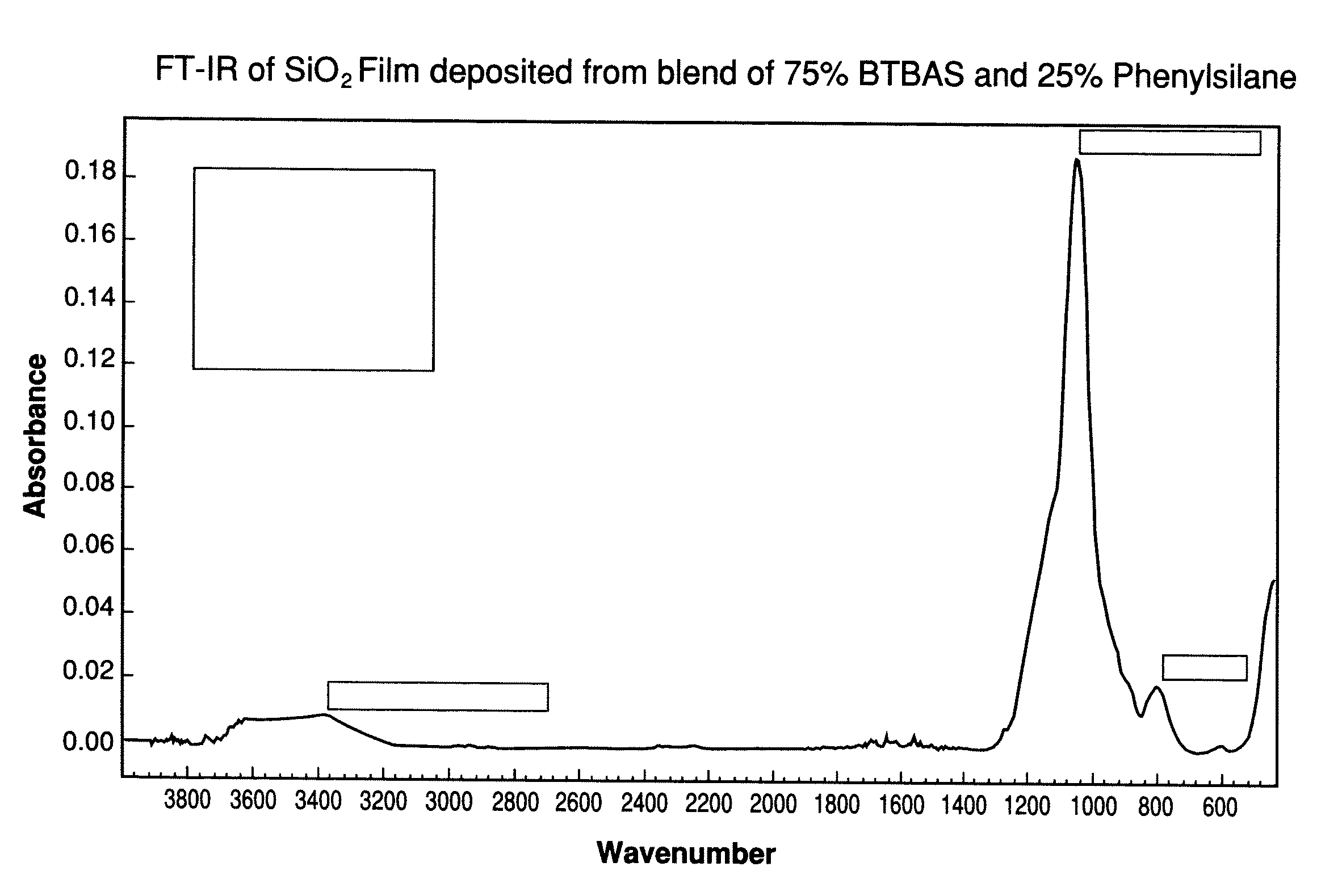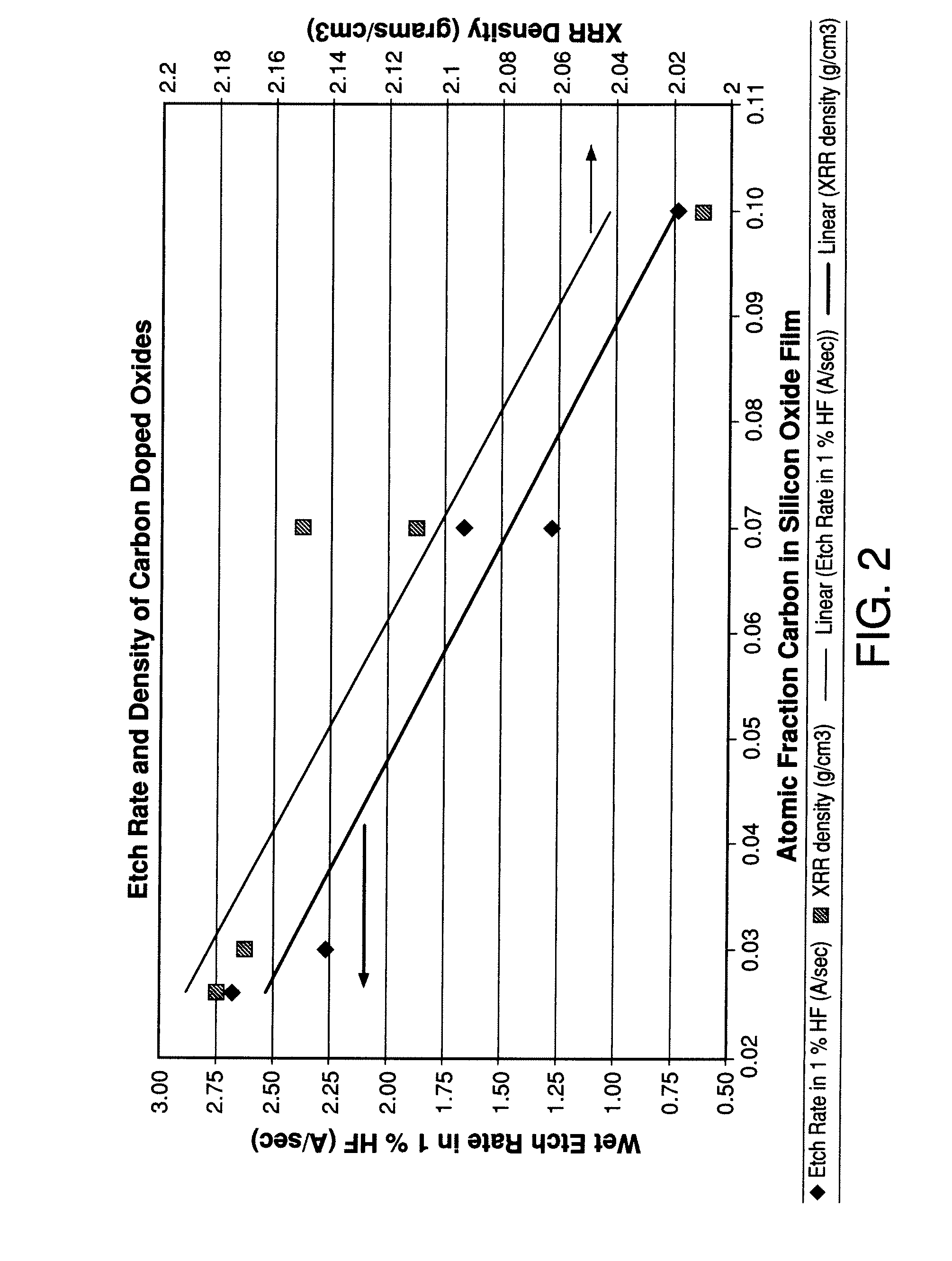Organosilane compounds for modifying dielectrical properties of silicon oxide and silicon nitride films
a technology of silicon nitride and organic silane, which is applied in the direction of coatings, chemical vapor deposition coatings, metallic material coating processes, etc., can solve the problems of not being able to be incorporated into the film being deposited, no experimental data to verify the feasibility of the approach, and little process flexibility available for altering the properties. , to achieve the effect of increasing the flow ratio, and increasing the etch resistan
- Summary
- Abstract
- Description
- Claims
- Application Information
AI Technical Summary
Benefits of technology
Problems solved by technology
Method used
Image
Examples
working examples
[0053]The following examples are provided for the purpose of further illustrating the present invention but are by no means intended to limit the same.
[0054]Example 1 is the standard process for making a SiO2 from BTBAS using a LPCVD process. This example is performed as a baseline for the other data.
[0055]Examples 2-5 are supporting data for the first approach in the present invention of making modified silicon oxides through an organosilane containing precursor in combination with an oxygen source.
[0056]Examples 6-9 are supporting data for the second approach in the present invention of modifying silicon oxides or silicon nitrides through carbon doping. More specifically, a process to deposit modified silicon oxides or silicon nitrides of using an existing precursor chemistry such as BTBAS doped with organosilane (containing carbon), such as phenylsilane. The advantage of this approach is that the film is derived from a chemistry already in use. Thus, there are fewer installation ...
example 1
Baseline Process
Deposition of Silicon Oxide from BTBAS
[0057]This is the standard process for making a SiO2 from BTBAS using a LPCVD process. The process conditions for this example were:
[0058]LPCVD Deposition, temperature was at 550° C., pressure was at 250 mtorr, flow ratio of O2:Precursor (BTBAS) was 2:1. The results were shown in Table 1.
TABLE 1RefractiveDielectric1% HF Wet Etch RateIndexConstant(Å / sec)1.4996.13.0
example 2
Deposition of Silicon Oxide from Phenylsilane
[0059]The process conditions for this example were:
[0060]LPCVD Deposition, temperature range was from 400° C. to 500° C., pressure was at 600 mtorr, flow ratio of Precursor (Phenylsilane):O2 was from 2:1 to 4:1. The results were shown in Table 2.
TABLE 2DepositionRefractiveDielectric1% Wet EtchTemp. (° C.)Precursor:O2IndexConstantRate4003:11.5311Not Measured0.104504:11.51633.810.165002:11.51174.120.56
PUM
| Property | Measurement | Unit |
|---|---|---|
| Temperature | aaaaa | aaaaa |
| Temperature | aaaaa | aaaaa |
| Pressure | aaaaa | aaaaa |
Abstract
Description
Claims
Application Information
 Login to View More
Login to View More - R&D
- Intellectual Property
- Life Sciences
- Materials
- Tech Scout
- Unparalleled Data Quality
- Higher Quality Content
- 60% Fewer Hallucinations
Browse by: Latest US Patents, China's latest patents, Technical Efficacy Thesaurus, Application Domain, Technology Topic, Popular Technical Reports.
© 2025 PatSnap. All rights reserved.Legal|Privacy policy|Modern Slavery Act Transparency Statement|Sitemap|About US| Contact US: help@patsnap.com



